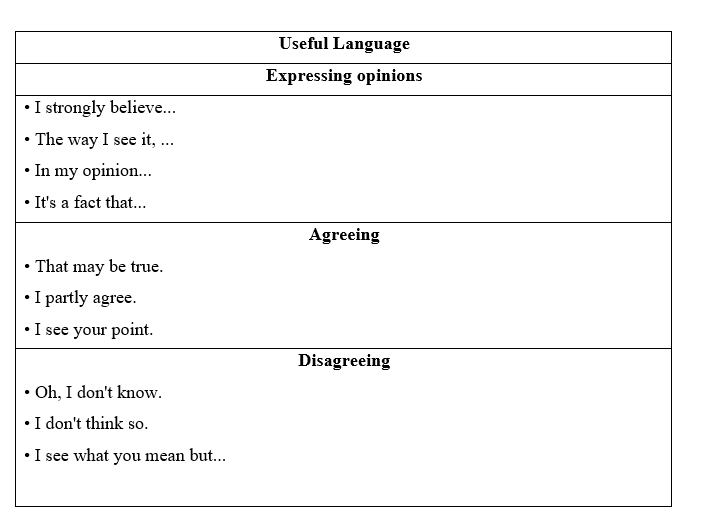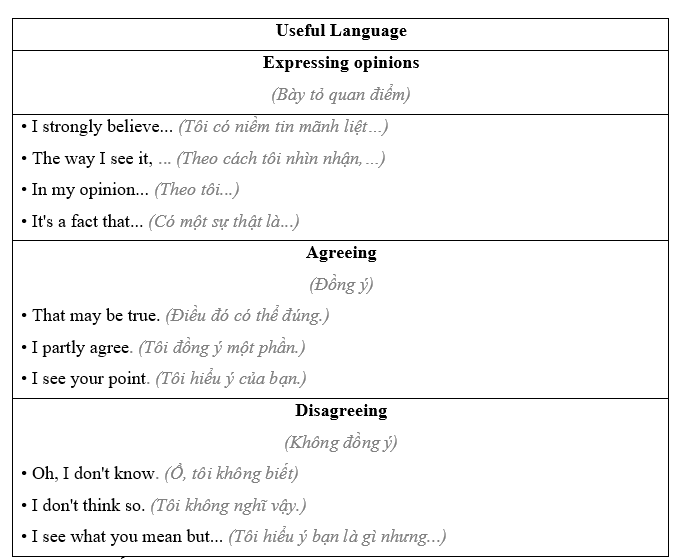Complete the following conversations by circling the best answers. (4 pts)
(Hoàn thành các đoạn hội thoại sau bằng cách khoanh tròn các câu trả lời đúng nhất.)
40. A: I’m afraid the charity event tomorrow has been cancelled due to bad weather.
B: __________! I’ve been looking forward to it all week!
A. I can sympathise
B. What a pity
C. What a surprise
D. I’m so sorry
41. A: I’ve just failed my test.
B: __________. Don’t feel too bad, but try harder next time.
A. I’m so ashamed to hear that
B. I’m so disappointed to hear that
C. I’m so sorry to hear that
D. I’m so shocked to hear that
42. A: I’m really __________ hiking.
B: Me too! Let’s go on a hike this weekend!
A. about
B. over
C. in
D. into
43. A: I can’t __________ the idea of killing animals for fur.
B: It’s cruel, isn’t it?
A. suffer
B. stand
C. deal
D. protect
Complete the following conversations by circling the best answers. (4 pts)
(Hoàn thành các đoạn hội thoại sau bằng cách khoanh tròn các câu trả lời đúng nhất.)
40. A: I’m afraid the charity event tomorrow has been cancelled due to bad weather.
B: __________! I’ve been looking forward to it all week!
A. I can sympathise
B. What a pity
C. What a surprise
D. I’m so sorry
41. A: I’ve just failed my test.
B: __________. Don’t feel too bad, but try harder next time.
A. I’m so ashamed to hear that
B. I’m so disappointed to hear that
C. I’m so sorry to hear that
D. I’m so shocked to hear that
42. A: I’m really __________ hiking.
B: Me too! Let’s go on a hike this weekend!
A. about
B. over
C. in
D. into
43. A: I can’t __________ the idea of killing animals for fur.
B: It’s cruel, isn’t it?
A. suffer
B. stand
C. deal
D. protect

40. B (Dùng “What a pity!” để bày tỏ sự nuối tiếc.)
A: I’m afraid the charity event tomorrow has been cancelled due to bad weather.
(Tôi e rằng sự kiện từ thiện ngày mai đã bị hủy do thời tiết xấu.)
B: What a pity! I’ve been looking forward to it all week!
(Thật đáng tiếc! Tôi đã mong chờ nó cả tuần!)
A. I can sympathise (Tôi có thể thông cảm)
B. What a pity (Thật đáng tiếc)
C. What a surprise (Thật bất ngờ)
D. I’m so sorry (Tôi rất xin lỗi)
41. C (Ta nói “I’m so sorry to hear that” khi muốn thể hiện sự cảm thông, chia buồn với người khác.)
A: I’ve just failed my test.
(Tôi vừa trượt bài kiểm tra của mình.)
B: I’m so sorry to hear that. Don’t feel too bad, but try harder next time.
(Tôi rất tiếc khi nghe điều đó. Đừng cảm thấy quá tệ, nhưng hãy cố gắng hơn vào lần sau.)
A. I’m so ashamed to hear that
(Tôi rất xấu hổ khi nghe điều đó)
B. I’m so disappointed to hear that
(Tôi rất thất vọng khi nghe điều đó)
C. I’m so sorry to hear that
(Tôi rất tiếc khi nghe điều đó)
D. I’m so shocked to hear that
(Tôi rất sốc khi nghe điều đó)
42. D (cấu trúc “be really into sth/V-ing” mang nghĩa “thực sự thích làm gì/cái gì”.)
A: I’m really into hiking.
(Tôi thực sự thích đi bộ đường dài.)
B: Me too! Let’s go on a hike this weekend!
(Tôi cũng vậy! Hãy cùng đi dã ngoại vào cuối tuần này nhé!)
A. about
B. over
C. in
D. into
43. B (cấu trúc “can’t stand sb/sth: không thể chịu đựng được ai đó/cái gì”.)
A: I can’t stand the idea of killing animals for fur.
(Tôi không thể chịu được ý tưởng giết động vật để lấy lông.)
B: It’s cruel, isn’t it?
(Thật tàn nhẫn phải không?)
A. suffer
B. stand
C. deal
D. protect

Các bài tập cùng chuyên đề
Bài 1 :
Expressing disappointment and sympathy
(Thể hiện sự thất vọng và đồng cảm)
1. Listen and complete the conversation with the expressions in the box. Then practise it in pairs.
(Nghe và hoàn thành cuộc hội thoại với các biểu thức trong hộp. Sau đó thực hành nó theo cặp.)
A. I can sympathise (Tôi có thể thông cảm)
B. I'm sorry to hear that (Tôi rất tiếc khi nghe điều đó)
C. What a pity (Thật đáng tiếc)
Mary: I'm afraid I can’t go to the cinema with you, Andy.
Andy: (1) ____________! I really wanted you to watch the film.
Mary: Maybe another time. My brother is going to see a doctor tomorrow and I promised to go with him.
Andy: (2) ____________. What's wrong with him?
Mary: He's been bullied at school. We think he’s suffering from depression and needs help.
Andy: (3) ____________. l was also the victim of bullying and had a very painful experience. I hope he'll be fine.
Mary: Thank you for your sympathy, Andy.
Bài 2 :
c. Read the Conversation Skill box. Then, listen and repeat.
(Đọc hộp Kỹ năng giao tiếp. Sau đó, nghe và lặp lại.)
|
Conversation Skill (Kỹ năng giao tiếp) Asking for more detailed information (Yêu cầu thông tin chi tiết hơn) To ask for more detailed information, say: (Để hỏi thông tin chi tiết hơn, hãy nói) A: Could you give me an example? (Bạn có thể cho tôi một ví dụ?) B: Yes, sure.... (Vâng, chắc chắn rồi....) A: Can you tell me more about (why they were built)? (Bạn có thể cho tôi biết thêm về (tại sao chúng được xây dựng) không?) B: No problem. They're... (Không sao. Họ đang...) |
Bài 3 :
d. Now, listen to the podcast again and number the phrases in the order you hear them.
(Bây giờ, hãy nghe lại podcast và đánh số các cụm từ theo thứ tự bạn nghe được.)
Bài 4 :
b) Which of the underlined phrases/ sentences are used for expressing opinions? agreeing? disagreeing?
(Những cụm từ / câu được gạch dưới được sử dụng để bày tỏ ý kiến? đồng ý? không đồng ý?)
Bài 5 :
3. Replace the underlined phrases / sentences in the dialogue in Exercise 2 with ones from the Useful Language Box.
(Thay thế các cụm từ / câu được gạch chân trong đoạn hội thoại ở Bài tập 2 bằng các cụm từ / câu có ích trong Hộp ngôn ngữ hữu ích.)
Tạm dịch

Bài 6 :
1. Complete the conversations by circling the best answers. Then practise reading them.
(Hoàn thành đoạn hội thoại bằng cách khoanh tròn câu trả lời đúng nhất. Sau đó thực hành đọc chúng.)
Conversation 1
Tom: I’m afraid I won’t be able to play in tomorrow’s match.
Dave: What ashamed!/a shame!
Conversation 2
Claire: My grandma has just passed away. I’m going to miss her so much.
Jane: What a pity/I’m so sorry to hear that.
Conversation 3
Nam: I tried my best, but my team didn’t win yesterday.
Dad: I know how it feels/that’s too bad, son. Don’t blame yourself.
Conversation 4
Mary: I had a terrible headache last night and couldn’t finish my homework.
Jim: I can sympathise with you./How disappointing! I often have headaches when I’m stressed.
Bài 7 :
Read the passage mark letter A, B, C or D to indicate the correct word for each of the blanks.
Researchers in communication show that more feelings and intentions are (1) ________ and received nonverbally than verbally. Mehrabian and Wiener following have stated that only 7% (2) _______ message is sent through words, with remaining 93% sent nonverbal (3) _________.
Humans use nonverbal communication because:
1. Words have limitations: There are (4) ________ areas where nonverbal communication is more (5) _______ than verbal, especially when we explain the shape, directions, personalities which are expressed nonverbally.
2. Nonverbal signals are powerful: Nonverbal cues primarily express inner (6) _______ while verbal messages deal basically with outside world.
3. Nonverbal messages are likely (7) ________ more genuine: because nonverbal behaviours cannot be controlled as easily as spoken words.
4. Nonverbal signals can express feelings inappropriate to state: Social etiquette limits (8) _________ can be said, but nonverbal cues can communicate thoughts.
5. A separate communication channel is necessary to (9) __________ send complex messages: A speaker can add enormously to the complexity of the verbal message through simple nonverbal (10) _______.
Question: with remaining 93% sent nonverbal (3) _________
-
A.
expressions
-
B.
thoughts
-
C.
gestures
-
D.
postures

















